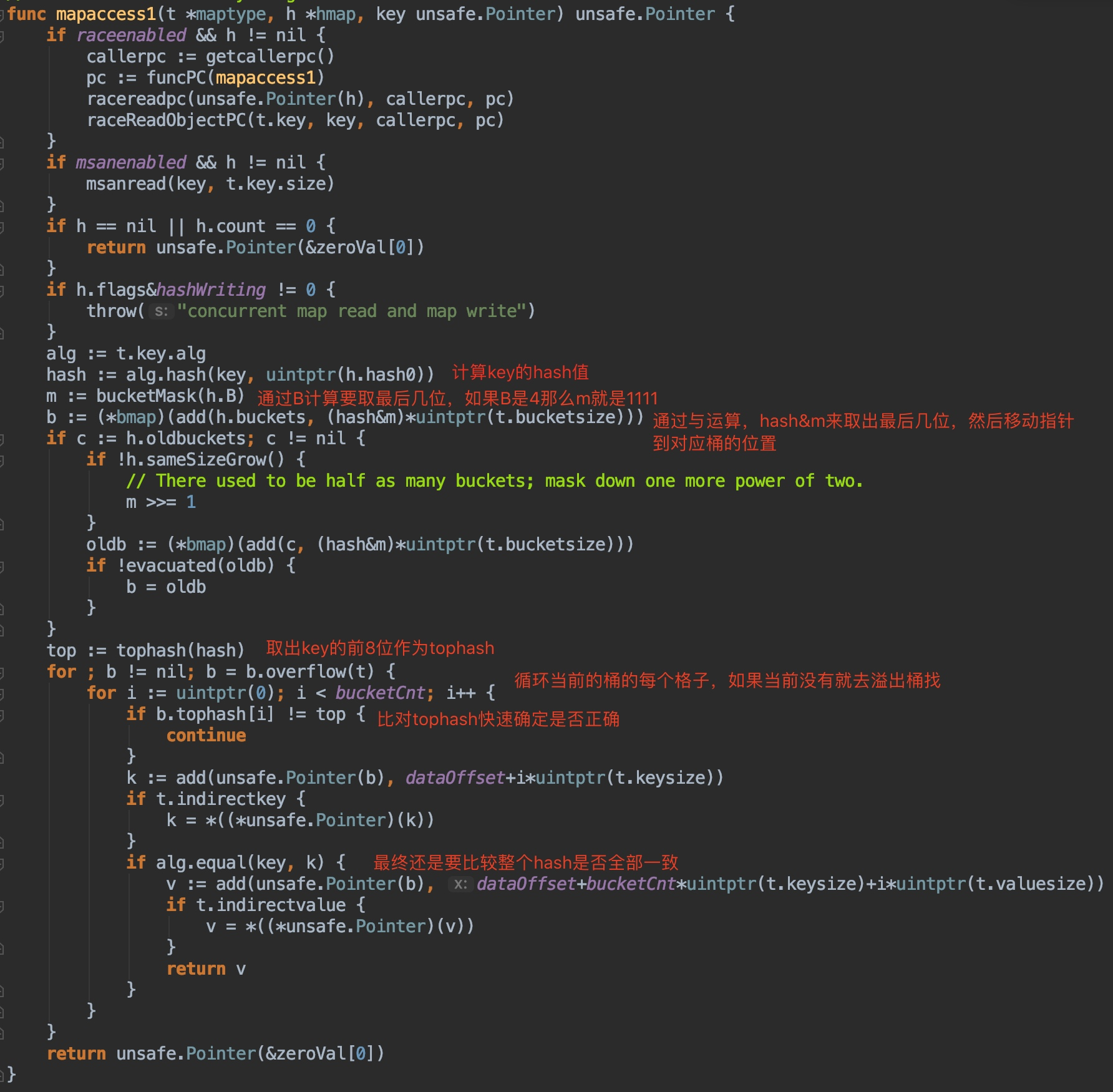map的实现细节
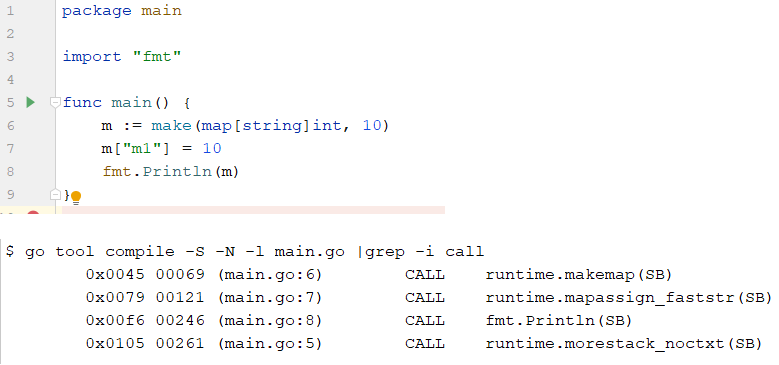
// makehmap_small implements Go map creation for make(map[k]v) and
// make(map[k]v, hint) when hint is known to be at most bucketCnt
// at compile time and the map needs to be allocated on the heap.
func makemap_small() *hmap {
h := new(hmap)
h.hash0 = fastrand()
return h
}
// makemap implements Go map creation for make(map[k]v, hint).
// If the compiler has determined that the map or the first bucket
// can be created on the stack, h and/or bucket may be non-nil.
// If h != nil, the map can be created directly in h.
// If h.buckets != nil, bucket pointed to can be used as the first bucket.
func makemap(t *maptype, hint int, h *hmap) *hmap {
.....
// initialize Hmap
if h == nil {
h = (*hmap)(newobject(t.hmap))
}
h.hash0 = fastrand()
// find size parameter which will hold the requested # of elements
B := uint8(0)
for overLoadFactor(hint, B) {
B++
}
h.B = B
......
return h
}
//初始化: 最重要的肯定就是确定一开始要有多少个桶,初始的大小还是很重要的,还有一些别的初始化哈希种子等等,问题不大。// A header for a Go map.
type hmap struct {
// Note: the format of the hmap is also encoded in cmd/compile/internal/gc/reflect.go.
// Make sure this stays in sync with the compiler's definition.
count int // # live cells == size of map. Must be first (used by len() builtin) (map的大小. len()函数就取的这个值)
flags uint8 // (map状态标识)
B uint8 // log_2 of # of buckets (can hold up to loadFactor * 2^B items)
// 可以最多容纳 6.5 * 2 ^ B 个元素,6.5为装载因子即:map长度=6.5*2^B
// B可以理解为map扩容了多少次
noverflow uint16 // approximate number of overflow buckets; see incrnoverflow for details
// (溢出buckets的数量)
hash0 uint32 // hash seed
// hash 种子
buckets unsafe.Pointer // array of 2^B Buckets. may be nil if count==0.
// 指向最大2^B个Buckets数组的指针. count==0时为nil.
oldbuckets unsafe.Pointer // previous bucket array of half the size, non-nil only when growing
//指向扩容之前的buckets数组,并且容量是现在一半.不增长就为nil
nevacuate uintptr // progress counter for evacuation (buckets less than this have been evacuated)
// 搬迁进度,小于nevacuate的已经搬迁
extra *mapextra // optional fields
}buckets这个参数,它存储的是指向buckets数组的一个指针,当bucket(桶为0时)为nil。
我们可以理解为,hmap指向了一个空bucket数组,
并且当bucket数组需要扩容时,它会开辟一倍的内存空间,并且会渐进式的把原数组拷贝,即用到旧数组的时候就拷贝到新数组。
// A bucket for a Go map.
type bmap struct {
// tophash generally contains the top byte of the hash value
// for each key in this bucket. If tophash[0] < minTopHash,
// tophash[0] is a bucket evacuation state instead.
tophash [bucketCnt]uint8
// Followed by bucketCnt keys and then bucketCnt elems.
// NOTE: packing all the keys together and then all the elems together makes the
// code a bit more complicated than alternating key/elem/key/elem/... but it allows
// us to eliminate padding which would be needed for, e.g., map[int64]int8.
// Followed by an overflow pointer.
}
// Go map 的 buckets结构
type bmap struct {
// 每个元素hash值的高8位,如果tophash[0] < minTopHash,表示这个桶的搬迁状态
tophash [bucketCnt]uint8
// 第二个是8个key、8个value,但是我们不能直接看到;为了优化对齐,go采用了key放在一起,value放在一起的存储方式,
// 第三个是溢出时,下一个溢出桶的地址
}bucket(桶),每一个bucket最多放8个key和value,最后由一个overflow字段指向下一个bmap,
注意key、value、overflow字段都不显示定义,而是通过maptype计算偏移获取的。
bucket工作机制
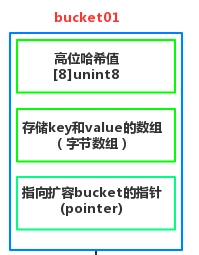
第一部分: tophash 存储的是哈希函数算出的哈希值的高八位。
是用来加快索引的。
因为把高八位存储起来,这样不用完整比较key就能过滤掉不符合的key,
1. 加快查询速度当一个哈希值的高8位和存储的高8位相符合,
2. 再去比较完整的key值,进而取出value。
第二部分,存储的是key 和value,就是我们传入的key和value,
注意,它的底层排列方式是,
key全部放在一起,value全部放在一起。
当key大于128字节时,bucket的key字段存储的会是指针,指向key的实际内容;
value也是一样。
这样排列好处是在key和value的长度不同的时候,可以消除padding带来的空间浪费。
并且每个bucket最多存放8个键值对。
第三部分,存储的是当bucket溢出时,指向的下一个bucket的指针
- bucket的设计细节
在golang map中出现冲突时,
不是每一个key都申请一个结构通过链表串起来,而是以bmap为最小粒度挂载,
一个bmap可以放8个key和value。
这样减少对象数量,减轻管理内存的负担,利于gc。
如果插入时,bmap中key超过8,
那么就会申请一个新的bmap(overflow bucket)挂在这个bmap的后面形成链表,
优先用预分配的overflow bucket,
如果预分配的用完了,那么就malloc一个挂上去。
注意golang的map不会shrink,内存只会越用越多,overflow bucket中的key全删了也不会释放get
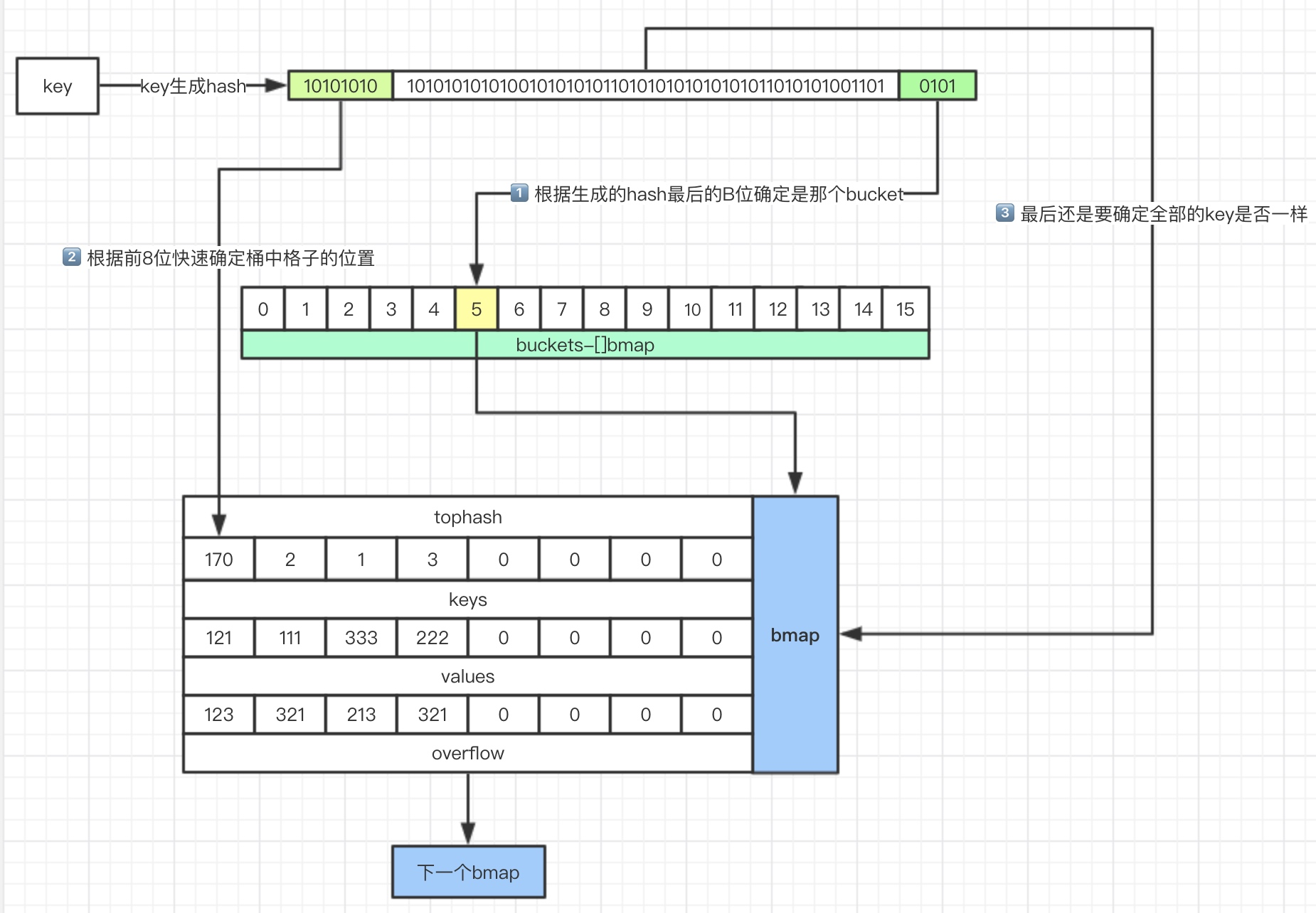
计算出key的hash
用最后的“B”位来确定在哪个桶(“B”就是前面说的那个,B为4,就有16个桶,0101用十进制表示为5,所以在5号桶)
根据key的前8位快速确定是在哪个格子(额外说明一下,在bmap中存放了每个key对应的tophash,是key的前8位)
最终还是需要比对key完整的hash是否匹配,如果匹配则获取对应value
如果都没有找到,就去下一个overflow找map由2个数据结构来存储数据.
第一个数据结构是一个数组, 内部存储的是用于选择桶的搞八位值, 这个数组用于区分每个键值对要存在哪个桶里
第二个数据结构是一个字节数组, 用于存放键值对. 该字节数组先一次存储了桶里所有key,再一次存储桶里所有的值.(节约内存)
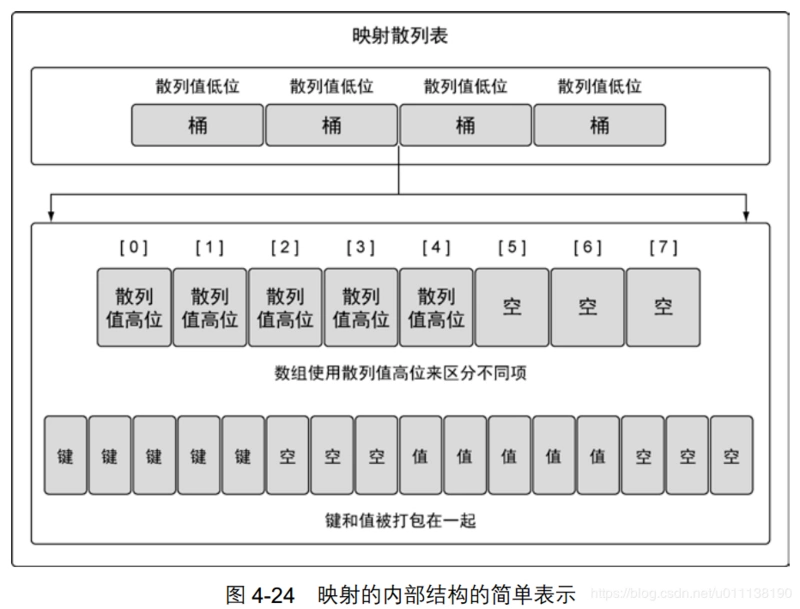
总结一下:通过后B位确定桶,通过前8位确定格子,循环遍历连着的所有桶全部找完为止。
那么为什么要有这个tophash呢?因为tophash可以快速确定key是否正确,你可以把它理解成一种缓存措施,如果前8位都不对了,后面就没有必要比较了。
